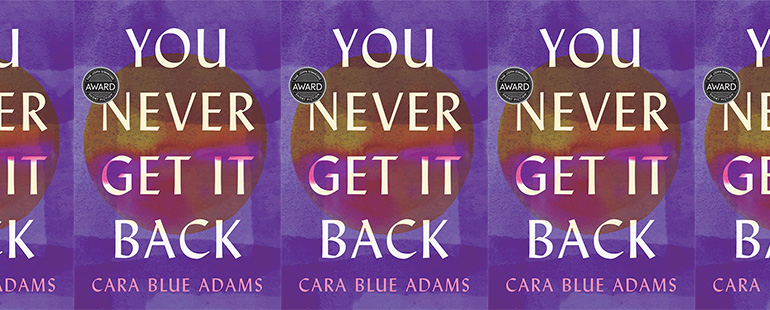Love and Loss in You Never Get It Back

You Never Get It Back, Cara Blue Adams’s stunning linked story collection published in December, centers on Kate, a young woman from New England who’s learning how to be in the world. A sensitive, thoughtful person, Kate’s introspection allows the reader to be with her as she grows and develops, as she comes into her own. The stories are told in both first and third-person voices, which allows Adams the ability to move both closer and farther away from Kate, allowing us to see her in different lights.
In four of the first person stories, Adams uses the direct address, the narrator speaking to another character using the pronoun “you.” The first person direct address is often a wonderful way to achieve intimacy in fiction, as it can bring the reader into the middle of a relationship. Both William Trevor’s Fools of Fortune (1983) and Jhumpa Lahiri’s triptych, “Hema and Kaushik,” from Unaccustomed Earth (2008), use it to great effect to explore the love between two characters over time. Adams also uses the direct address to explore love and to consider the loss that love often leaves behind.
The opening story in the collection, “I Met Loss the Other Day,” is a fascinating place to begin a realist book, as it’s a metaphorical piece, with echoes of Kafka and Borges and Dickinson. The first-person narrator is a tailor, who meets the personified character of Loss when he comes to be fitted for a suit. She learns about the empire that Loss controls, warehouses full of clerks keeping track of the losses that everyone has endured. In place of payment, the narrator asks to see Loss’s records, and Loss gives her three manila notecards. She reads the items on one of the cards: “Gold filling, the first card began. Train schedule. Yellow slicker just before the sky opened. Bearings (ball). Bearings (sense of). Orange rind. Tax forms.” Then the story, just as it ends, shifts abruptly:
Before he let himself out, Loss brushed my cheek lightly with the back of his knuckles—just the way you always would. Just the way I know you will again, after you walk barefoot down the dirt drive to your mailbox, slit open my envelope and find these cards, after you finally hold in your hand what for all those years I could never bring myself to show you.
The use of the direct address here is surprising and wonderful, a way to segue and pivot from the metaphorical to the real, a way to invite the reader into the book to come. We have been lulled into the construct of the story, and the use of the direct address makes us sit up and pay attention. We don’t know to whom the narrator is speaking—although on a reread of the collection, we may have a guess—but it seems clear that the losses on those cards, and others, will be recounted in this book. The cards have been sent to this person as a way to share what was never told. There is a way in which the conclusion to this story opens and unfurls, providing a sense of what is to come.
In “The Foothills of Tucson,” the fourth story in the collection, Kate has moved away from the east coast to attend graduate school in Arizona. The direct address is introduced early here, and it continues throughout the piece. Kate is speaking to a former lover, and we learn that it has been over two years since she’s moved, and more than that since the break-up: “The panic I felt when you said we had to separate: I think it was in part because I’d never seen a life I would want before I met you, and I didn’t believe I could make a life like that—like yours—for myself. But it wasn’t just that. I know that now, when so many days you are the only person I want to talk to. I call friends, go through four or five, before I know for sure.” The pain and the loss that Kate feels, even two years down the line, is palpable. The direct address allows us to feel that loss as she experiences it, to feel her pain that comes from the fact that this person is no longer in her life. We only learn about their relationship in this way—there’s not a story that features him in the present moment—and this highlights the way that loss can become more present than the thing itself.
Because Kate’s former lover is never named, and we do meet other—named—partners and friends in the collection, he becomes even more of a blank space or a black hole. His lack of a name makes his presence loom larger. We only get to see him through what she says to him, the story moving back and forth between her present in Arizona and her memories of being with him. By having Kate speak directly to him throughout the story, telling her side of their relationship, we understand how present he still is in her life. He is not there but she recreates his presence by speaking to him. And yet, we see her moving forward and away from him, making a conscious decision not to return to Boston, where he is, but to choose a separate path.
An attachment to an old lover can be addictive, and the direct address works to show us that as well: “Sometimes I’m not sure I want to let go. There’s something sad about leaving sadness behind. If I miss you every day, it means at least there’s something I want. You get dimmer and dimmer in my memories, though. I dream about you and wake, feeling a clutching in my chest as you fade, a person flattening into a paper doll.” Without the direct address, this sentiment wouldn’t come across as cleanly. But as Kate speaks to her ex, we are with her in her obsession, in her longing, in her solitude. The direct address allows her to be brutally honest, with her partner and with herself. We, too, want her to move on, and yet we understand the pull of the past, the former life that has not yet receded. Over the course of the story, though, we see Kate moving from wanting her former partner to still be in her life to understanding that they were never meant to be. Talking directly to someone, it turns out, even it is only a monologue, can be a good way to figure out the right way forward. “The Foothills of Tucson” is the final story in the first part of the collection, and there is a conclusive feel to its ending.
“Shoulder Season,” is a very short piece that concludes the second part of the collection; it carefully uses white space to create meaning. Kate is still in Arizona, but we learn over the course of the story that she has decided to leave her PhD program. She is housesitting for her advisor when she sees a rattlesnake and begins to shake: “The night before this, my ex-boyfriend had emailed me. Not Javier, not Michael, but the person for whom I had once lain awake all night, unable to sleep, and eventually walked myself to the hospital, saying that I thought I was losing my mind.” The ex tells her that he has dreamt about her and that he still misses her. We assume that this is the same, unnamed ex-boyfriend. He doesn’t tell her that he’s about to get married, but she knows this, from tracking him online. She even knows that “his fiancée had registered for plain white towels.” She deletes his email but then spends time trying to retrieve it. Still, we understand that she has moved to a better place, given that she is not speaking to him directly. The loss has clearly become less of a burden.
After her advisor returns, she tells him that she is leaving the doctoral program. She has begun to write, and she wants more time to explore that. She can’t explain it all to her advisor, and she can’t really explain it to herself, either, except that she knows it’s the right decision: “It was a bit like falling in love. Much harder, but as helpless-making.” White space follows this statement and provides for the reader a moment to equate these things in their mind.
And then a new fragment begins:
Your face: the thing I loved best. The thing I watched doors for.
A salt-rim moon. A dry, rustling wind.
One of the most shocking things, I would come to find, was how easily my life dropped away.
We have returned again to the direct address, and although we are not told, we assume we have returned to the ex. But this direct address is different from that used in the earlier story—here, it is just a glimpse, an elegiac and poetic moment. The ex will not disappear from her memories, perhaps, but he is no longer an obsession. The love and the watching are now in the past tense.
In “Vision,” the first story of the third and final part of the collection, the direct address is used only once as well. Kate is now at a writers’ residency, struggling to write a novel, and learning from the other artists in her midst. “What can I tell you about my life at that time? It was a quiet life, constrained. I spoke little. I smiled. My friends did not know my true desires, my longings. I lived in a hot place far from home.” Because of the earlier uses of the direct address, we initially assume that the narrator is speaking to her ex. But that does not seem to be the case. Instead, the narrator seems to be speaking directly to the reader. An enormous shift has occurred. As Kate has become a writer, her focus has changed; before, she wouldn’t have thought to address the reader. But the reader is now the one who receives Kate’s most intimate thoughts, those things that she doesn’t even tell her friends. Her reflections on loss and love now end up on the page.
Adams so skillfully deploys the direct address in this collection. She uses it to different effects, providing surprise, insight, and intimacy. The love and loss that is examined throughout is heightened by these craft choices; the narrative arc that is created through its use underscores the narrative arc of the collection and carries the reader through the book to its wonderful, hopeful end.



